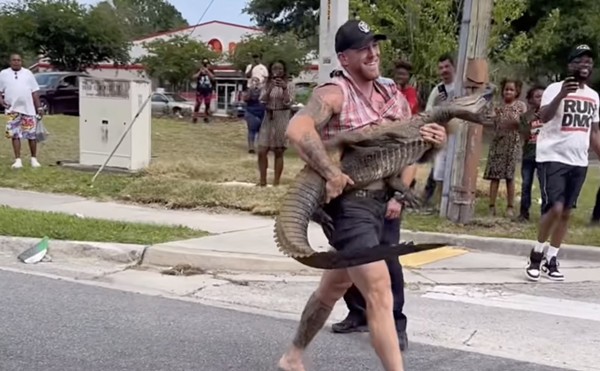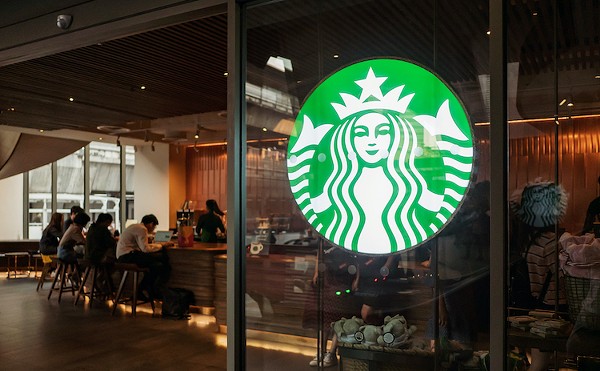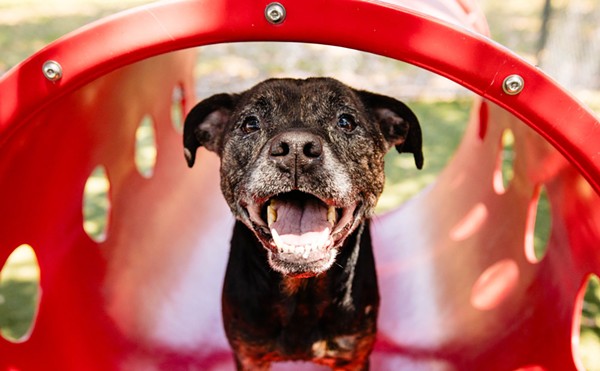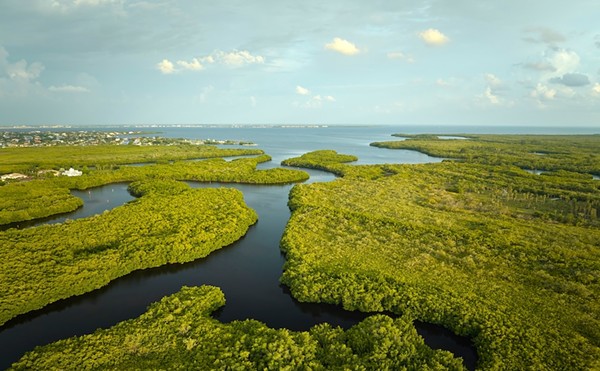Sometimes a picture says it all. A black-and-white photograph of a young man, sinewy and lean-muscled. The look on his face, detached; the look of the rest of him — all of the rest of him — decidedly attached. A large, semihard member is slapped on his right leg, hanging out for all the world to see. Amid the text littering his strong thighs, there are hints of just how it used to be for the gay man in Orlando circa 1976.
It's an advertisement for Parliament House, the "world's largest gay entertainment complex," boasting $8 hotel rooms with televisions. But the whole effect, from the boldness of the nudity to the suggestive sparseness of the shot itself, illustrates the beguiling terms of homosexuality in a semifictitious region thrown onto the map by the coming of Walt Disney World. If you could handle the bluntness, then you were welcome.
That picture, among many others, is part of Central Florida's Gay Lesbian Bisexual Transgendered History Exhibit, an ambitious attempt to archive the largely hearsay-based cultural history of local homosexuality, which the Metropolitan Business Association — the gay chamber of commerce — will present with the Come Out With Pride parade Sunday, Oct. 15, at the Orange County Regional History Center. The association, with little fanfare, put forward a less organized presentation last year.
This year, a committee of eight activists spent months rifling through tucked-away relics to try to divine a cohesive story line for Orlando's gay history. "People are desperate for this to happen," says committee chair Ken Kazmerski, sitting in front of a messy memorabilia table at the Gay Lesbian Bisexual Community Center (more commonly known simply as the Center) on Mills Avenue. But making it happen is the real challenge. There's a distinct absence of "real history" available: a poster from a Lily Tomlin AIDS benefit or a picture of four scantily clad guys mugging in front of the Parliament House marquee here, copies of various newsletters there. And most questions about actual dates are met with a vague, "I don't know, I think it was around '87 or maybe '91."
The committee has come up with a multimedia extravaganza to fill the first floor of the history museum, including DVD presentations (showing pride parades, the bar scene and the movie Paul Wegman: A Tribute, about the late Parliament House drag queen known as "Miss P."), a Wall of Courage highlighting the efforts of six deceased activists and a timeline from the '60s to the present. (The information is also being archived on the website www.gayorlandohistory.com.)
"Originally we started just trying to clean closets out," says committee member David Bain, an editor of Watermark predecessor The Triangle, who's lived here since 1979. "There was just a lot of stuff that we had that we were worried was going to be lost."
It's an imperfect science. "Most of it was literally having to read old newspapers, and even then … I remember when we used to make them, and we would forget to change the headers, `so` it would have the wrong month or year on it. It would say 1991 on the cover and then 1992 on the inside," Bain says. "The big thing that we've been getting the biggest chuckle about was the big divide between the men and the women in the early days, in the '80s."
Enter Charlene Bell, a committee member who was inspired by a piece on Parliament House history this newspaper published three years ago (see "Under the rainbow … by the Carolina Moon," May 29, 2003), wherein the history center met inquiries on gay history with, well, not much. Bell hopes that by devising an actual timeline she can write a comprehensive book on Orlando's gay history. She came out in the '70s in Orlando.
"For women, it began in the mid-'70s with what were called ‘Moon Parties,'" she says, "and those eventually took on a political overtone. They started off as a social gathering for women who wanted to have a conversation and do something else outside of the bars."
Adds Bain: "At that time, the community was trying so hard to have something that wasn't related around the bars. But the bars were the only way that you could get information out. People didn't even like to get on mailing lists."
There's a preponderance of bar memorabilia featured in the exhibit, with good reason. The bar scene was all there was when few wanted to be outed in the light of day.
In the 1980s, the tides shifted with the AIDS epidemic. Being gay could no longer be a series of illicit night crawls and secret meetings. AIDS was front-page news, and this burgeoning community was put in a position of legitimate outrage — because the government didn't care — and anxiety. Orlando's underdeveloped gay community had to step up to the plate.
"It was front-of-newspaper headlines," says Michael Slaymaker, who lobbied the city to pass an anti-discrimination ordinance known as Chapter 57 in 2002. "We weren't used to being there. But I think that we said, ‘Well, we're here. And while we're here, I have a couple of other things I'd like to say.' I don't necessarily dress up like Queer Nation and chain myself to the front door of any government building, but I try `to effect change` in other ways. And that, I think, is sophistication, and I think often times elected public officials respond best to that."
Sophistication comes with time. Just ask Michael Wanzie, who headed the Center in the late '80s and now handles public relations for the Parliament House: "I think the biggest motivating factor in creating a forward motion that eventually ended up with `Chapter` 57 going our way was really bringing to the forefront how slanted the police were in this town in their treatment of gay people, whenever they got caught for anything. The way that ordinances were being used selectively against gays."
He points to an initiative he started, affectionately labeled SLAP, or "Sharing Love and Affection in the Park." In the late 1980s, he says, Orlando cops targeted gays who left designated walkways in Langford Park on suspicion that they were illegally canoodling. While some were, most weren't. Wanzie and fellow activists challenged the arrests and got the innocents' names cleared.
Tactics change, and views moderate. Sometimes progress comes incrementally, particularly for the gay community. But it has come, thanks to those who, whatever their methods, stood up, spoke their minds and demanded something better.
"I think we should celebrate the people who've done something in this community," says city commissioner Patty Sheehan, Orlando's first openly gay elected official. "Some of the people, a lot of them, aren't with us, and I think that's also important to remember."
With this exhibit — still in a fledgling scrapbook phase, but with aims of growing into archived permanence — maybe Orlando can start to do just that.
| Here are some of the milestones featured in an exhibit at the Orange County Regional History Museum opening Oct. 15 |
|
1960s Cactus Room, Orange Avenue: Early incarnation of the legendary Cactus Club (see 1990s). Tropitan: A gay bar we’ve never heard of. 1970s Florida Technical University Gay Student Association/University of Central Florida Gay Lesbian and Bisexual Student Union: A gay student group takes root on campus. Gay Social Services: Original incarnation of the gay community group. Gay Hot Line: Service provided by GSS to assist with the coming-out process. Gay Skate: Social gatherings on wheels! Still happening. Moon Parties: Lesbian social gatherings with a political angle. The Parliament House (1975): The sun around which the whole gay community still orbits. 1980s Bears of Central Florida: Nonprofit social organization of big, hairy men best known for annual Bear Bust parties. “May the fur be with you” is a slogan. CENTAUR: HIV/AIDS counseling, with focus on behavioral problems and addiction. The Gay Lesbian Bisexual Community Center: Home of the gay community organization. Located on Mills Avenue and known simply as the Center. Face to Face/Faces: Orlando’s only lesbian bar, on Edgewater Drive. Full Moon Saloon: Parliament House’s younger, hairier brother-next-door. Gay Alcoholics Anonymous: Natural byproduct of a thriving bar scene. Gay Community Services: Second incarnation of GSS. Gay Escape I (1987): First all-gay cruise in Central Florida. Raised $28,000 for the Center. Hank’s: Gay dive bar with a fruitful back yard. Hope and Help Center (1988): Nonprofit HIV/AIDS service organization started to help one person; grew to help many. Headdress Ball (1989): Hope and Help Center’s first annual fund-raising gala. Joy Metropolitan Community Church (1981): Gay-focused house of worship on Ferncreek Avenue. Love and Commitment Network: Lesbian social group. The Loading Dock: Early gay bar operated out of industrial dairy space. Or-lambda Sentinel: Lesbian newspaper. Not affiliated with the daily. Phoenix/New Phoenix: Gay bar near UCF. Southern Changes/Southern Nights: Legendary gay disco on Bumby Avenue, now under new ownership. Famous for its congested bathrooms. Triangle Newspaper: Early incarnation of Watermark. 1990s Cactus Club: Pivotal gay bar relocates to proto-ViMi district. Club at Firestone: Saturday nights were gay nights. Now it’s Wednesday. Club Orlando: Gay gym with changing rooms and a reputation. Gay Day at Disney World (1991): Huge gay parties at Mouse World every June for the past 15 years. Ensuing boycotts by right-wing hatemongers routinely ignored. Now an all-consuming tourist extravaganza. Gay Pride Parade: The Ku Klux Klan visited its earliest installments. Log Cabin Republicans: Local chapter of gay Republicans, headed by Patrick Howell. Metropolitan Business Association: The gay chamber of commerce. Out & About Books: Bookstore/center of commerce for the gay community. Pride Flags (1998): The city erects gay pride flags downtown. The Rev. Pat Robertson threatens us with destruction via hurricanes and meteors for our embrace of sin. Hurricanes come six years later; still awaiting meteors. Rainbow Democratic Club: Gay Democratic organization. Ritzy Rags: Wigs and cocktail attire for “ladies” with large feet. Sadie’s Tavern: Former lesbian hangout on Orlando Avenue in Winter Park. Union Café: Now Bravissimo, was home of the best gay Sunday brunch ever. Watermark: Gay newspaper, still printing. 2000s Chapter 57 (2002): Orlando passes an anti-discrimination ordinance. Patty Sheehan (2000): First openly gay elected official in the City of Orlando. Peacock Room: Gay-owned, all-inclusive bar on Mills Avenue. Pulse: Stylish gay bar opens on South Orange Avenue. Studz: Now in old Cactus space on Mills; black paint implies severity. Billy Manes for Mayor (2005): The city’s first openly gay mayoral candidate. Had the election not been called off and Buddy Dyer reinstated, respected political analysts agree Manes’ “Little, Yellow, Different” campaign slogan would have led him to a landslide victory at the ballot box — and that the TD Waterhouse Centre would now be a bar. A really expensive bar. — Billy Manes |


















